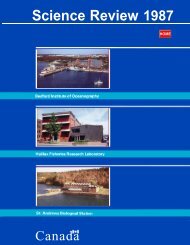POAC 09 - Bedford Institute of Oceanography
POAC 09 - Bedford Institute of Oceanography
POAC 09 - Bedford Institute of Oceanography
You also want an ePaper? Increase the reach of your titles
YUMPU automatically turns print PDFs into web optimized ePapers that Google loves.
2001. The Petermann Glacier is located in northwest Greenland, and seaward <strong>of</strong> the grounding<br />
line, it consists <strong>of</strong> a floating glacier tongue about 70 km long and 15.5 km wide (Higgins, 1991).<br />
Another major calving event occurred in the summer <strong>of</strong> 2008, mostly in the form <strong>of</strong> a single ice<br />
island over 20 km 2 in area. This paper describes its drift southward, by tracking it using satellite<br />
imagery (Envisat and MODIS), and two satellite-tracked ice beacons deployed on the ice island.<br />
DRIFT FROM THE PETERMANN GLACIER TO JONES SOUND<br />
A MODIS image from 18 July 2008 (Fig. 1) shows the large ice island (A) which calved from the<br />
west side <strong>of</strong> the glacier by 13 July, and a smaller ice island (B) which calved from the east side<br />
by 16 July. The large ice island calved along a fracture line E similar to the position <strong>of</strong> the front<br />
in 2000. This fracture line may have formed due to basal melting observed along one <strong>of</strong> several<br />
channels near the grounding line <strong>of</strong> the glacier (Rignot and Steffen, 2008).<br />
A<br />
C<br />
Fig. 1. MODIS Image from 18 July 2008 (1920Z) showing two ice islands (A and B) calved from<br />
the Petermann Glacier (C), and sea ice to the north in Nares Strait (D). The bottoms <strong>of</strong> the arrows<br />
indicate the origin <strong>of</strong> the ice islands.<br />
The large ice island was tracked using Envisat and MODIS imagery between 13 July and 15<br />
September 2008, when two ice beacons were deployed on the ice island northeast <strong>of</strong> Jones<br />
Sound. The complete track <strong>of</strong> the ice island from the Petermann Glacier south to Lancaster Sound<br />
between 13 July and 10 February 20<strong>09</strong> is shown in Fig. 2.<br />
Although the ice island calved in mid-July, the ice island did not enter Nares Strait for 3 weeks<br />
until a major wind event cleared sea ice from the mouth <strong>of</strong> the Petermann Fjord. The mean sea<br />
level pressure pattern between 01 August and 06 August 2008 using NCEP/NCAR reanalysis<br />
data (Kalnay et al., 1996) shows that strong winds blew northward through Nares Strait (Fig. 3).<br />
A passive microwave (AMSR-E) image for July 31 shows high concentrations <strong>of</strong> sea ice both<br />
B<br />
E<br />
D



